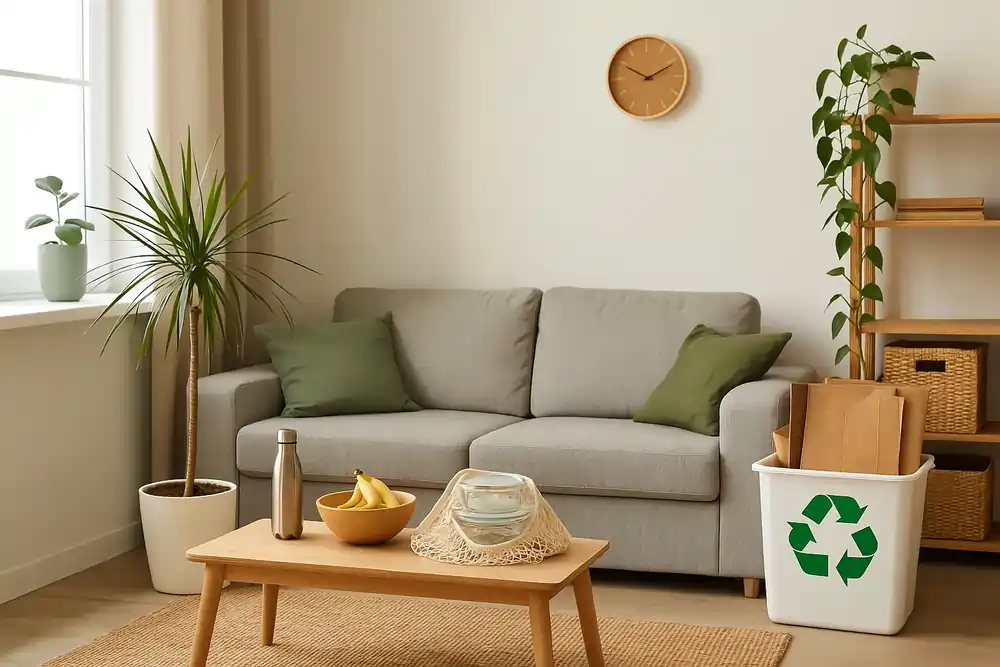Living sustainably isn’t limited to homeowners — renters can significantly reduce their environmental footprint with thoughtful choices and small lifestyle changes. Whether you’re in a high-rise apartment, a duplex, or a rented house, adopting eco-friendly habits can help protect the planet and often save money in the process.
This guide explores practical and achievable sustainability tips for renters, organized by living space, habits, and budget level.
🌍 What Is Sustainable Living?
Sustainable living means making daily choices that reduce your impact on the environment. This includes:
- Reducing waste generation
- Conserving energy and water
- Choosing eco-friendly products
- Supporting ethical and local businesses
- Living in alignment with environmental protection goals
As a renter, you might not have control over construction materials or major appliances, but you can make significant changes within your living space.
🏠 Sustainable Apartment Modifications (That Are Landlord-Friendly)
Even with rental restrictions, there are many non-permanent, damage-free changes you can make.
1. Switch to LED Bulbs
- Replace incandescent or CFL bulbs with energy-efficient LED lights.
- LEDs use up to 90% less energy and last much longer.
2. Install a Low-Flow Showerhead
- Use a removable low-flow showerhead to cut water usage by up to 50%.
- Brands like Niagara or High Sierra offer renter-safe options.
3. Use Removable Weather Stripping
- Improve thermal insulation by sealing windows and doors.
- Prevents drafts and reduces heating/cooling costs.
4. Add Thermal Curtains
- Insulating curtains reduce heat loss in winter and keep your space cooler in summer.
- Also blocks light, aiding sleep and reducing need for A/C.
5. Smart Power Strips
- Phantom energy from plugged-in devices can account for up to 10% of electricity bills.
- Use smart or timer power strips to cut off unused energy automatically.
🛒 Sustainable Consumption Habits
What you buy and use daily has a huge impact. Here’s how to become a more conscious consumer as a renter.
1. Buy Secondhand Furniture and Decor
- Check Facebook Marketplace, Thrift Stores, or Buy Nothing Groups.
- Reduces landfill waste and supports the circular economy.
2. Choose Refillable and Reusable Products
- Use glass jars, refillable soap dispensers, reusable water bottles, and cloth towels.
- Reduces reliance on single-use plastics.
3. Opt for Natural Cleaning Products
- Avoid toxic chemicals that harm indoor air quality and water systems.
- DIY cleaners (e.g., vinegar + baking soda) or buy eco-brands like Seventh Generation, Ecover, or Dr. Bronner’s.
4. Buy in Bulk
- If space allows, buy pantry staples like rice, beans, and oats in bulk using reusable containers.
♻️ Waste Reduction and Recycling
Reducing waste is one of the most effective sustainable living practices.
1. Compost Scraps (Even Indoors!)
- Use countertop compost bins or services like Bokashi composting.
- Some cities offer community compost drop-offs.
2. Set Up a Recycling Station
- Separate recyclables based on your city’s waste management rules.
- Label bins clearly to prevent contamination.
3. Avoid Fast Fashion
- Choose timeless clothing pieces made from organic cotton, hemp, or recycled materials.
- Shop from ethical brands or swap clothes with friends.
🔌 Energy and Water Conservation
Small changes in how you use resources can make a big difference.
1. Turn Off and Unplug Devices
- Always unplug when not in use — especially kitchen appliances, chargers, and electronics.
2. Run Full Loads
- Run your dishwasher or laundry machines only when full.
- Use cold water washes to save on heating energy.
3. Air Dry Laundry
- Use a drying rack or clothesline instead of a dryer.
🌱 Indoor Sustainable Living Practices
Your day-to-day habits influence your sustainability efforts the most.
1. Grow Herbs Indoors
- Use windowsills or vertical planters to grow basil, mint, cilantro, and more.
- Reduces plastic herb packaging and food waste.
2. Meal Plan to Avoid Food Waste
- Plan your meals weekly and shop intentionally.
- Use up leftovers creatively.
3. Practice Mindful Consumption
- Before buying anything, ask: “Do I really need this?”
- Quality over quantity reduces clutter and waste.
🚴♂️ Eco-Friendly Transportation for Renters
Living in rented urban or suburban areas often means better access to public transport and walkable areas.
1. Use Public Transport or Bike
- Reduces reliance on personal cars and lowers emissions.
- Use apps like Moovit, Google Maps, or Transit to plan routes.
2. Carpool or Share Rides
- Split emissions and fuel costs with neighbors or coworkers.
3. Remote Work When Possible
- If you can, reduce commuting altogether by working from home.
🏘️ Engage With the Community and Advocate
Even renters can have a voice in shaping sustainable policies and neighborhoods.
1. Support Local Farmers and Businesses
- Buy produce at farmers’ markets or subscribe to CSA boxes.
2. Talk to Your Landlord
- Ask about installing solar panels, bike racks, or EV charging stations.
- Sometimes landlords are open to upgrades if you show cost savings.
3. Join Eco-Friendly Groups
- Connect with others via Facebook, Meetup, or local green initiatives.
- Participate in cleanups or sustainability advocacy events.
Final Thoughts: Living Green as a Renter Is Possible
You don’t need to own a home to live sustainably. With smart choices, renters can make their spaces more energy-efficient, reduce waste, and lower their carbon footprint — all while saving money and living more intentionally.
Sustainability is less about perfection and more about consistent progress.
📋 Quick Checklist: Sustainable Living for Renters
| Area | Sustainable Actions |
|---|---|
| Lighting | Switch to LED bulbs |
| Water | Low-flow showerhead, full laundry loads |
| Waste | Recycle, compost, reduce packaging |
| Shopping | Thrift, buy local, reusable products |
| Transportation | Bike, walk, carpool |
| Food | Meal plan, buy bulk, grow herbs |
| Energy | Smart power strips, unplug devices |


Leave a Reply